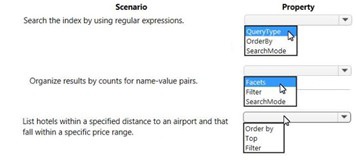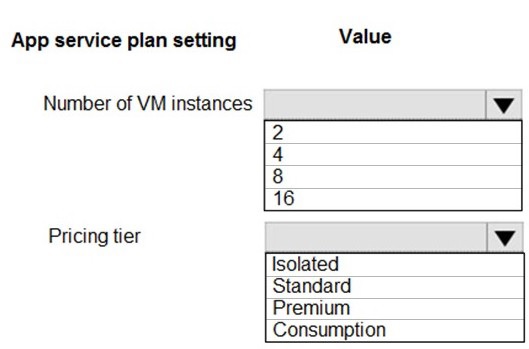Topic 4, Misc. Questions
Note: This question is part of a series of questions that present the same scenario.
Each question in the series contains a unique solution that might meet the stated
goals. Some question sets might have more than one correct solution, while others
might not have a correct solution.
After you answer a question in this section, you will NOT be able to return to it. As a
result, these questions will not appear in the review screen.
You are developing a website that will run as an Azure Web App. Users will authenticate by
using their Azure Active Directory (Azure AD) credentials.
You plan to assign users one of the following permission levels for the website: admin,
normal, and reader. A user’s Azure AD group membership must be used to determine the
permission level.
You need to configure authorization.
Solution:
Create a new Azure AD application. In the application’s manifest, define
application roles that match the required permission levels for the application.
Assign the appropriate Azure AD group to each role. In the website, use the value
of the roles claim from the JWT for the user to determine permissions.
Does the solution meet the goal?
A.
Yes
B.
No
No
To configure Manifest to include Group Claims in Auth Token
Go to Azure Active Directory to configure the Manifest. Click on Azure Active
Directory, and go to App registrations to find your application:
Click on your application (or search for it if you have a lot of apps) and edit the
Manifest by clicking on it.
Locate the “groupMembershipClaims” setting. Set its value to either
“SecurityGroup” or “All”. To help you decide which:
“SecurityGroup” - groups claim will contain the identifiers of all security groups of
which the user is a member.
“All” - groups claim will contain the identifiers of all security groups and all
distribution lists of which the user is a member
Now your application will include group claims in your manifest and you can use this fact in
your code.
Reference:
https://blogs.msdn.microsoft.com/waws/2017/03/13/azure-app-service-authentication-aadgroups/
You are validating the configuration of an Azure Search indexer.
The service has been configured with an indexer that uses the Import Data option. The
index is configured using options as shown in the Index Configuration exhibit. (Click the
Index Configuration tab.)

You develop a serverless application using several Azure Functions. These functions
connect to data from within the code.
You want to configure tracing for an Azure Function App project.
You need to change configuration settings in the hostjson file.
Which tool should you use?
A.
Azure portal
B.
Azure PowerShell
C.
Azure Functions Core Tools (Azure CLI)
D.
Visual Studio
Azure portal
Explanation:
The function editor built into the Azure portal lets you update the function.json file and the
code file for a function. The host.json file, which contains some runtime-specific
configurations, is in the root folder of the function app.References:
https://docs.microsoft.com/en-us/azure/azure-functions/functions-reference#fileupdate
You are developing a .NET Core MVC application for customers to research hotels. The
application will use Azure Search. The application will search the index by using various
criteria to locate documents related to hotels. The index will include search fields for rate, a
list of amenities, and distance to the nearest airport.
The application must support the following scenarios for specifying search criteria and
organizing results:
• Search the index by using regular expressions.
• Organize results by counts for name-value pairs.
• List hotels within a specified distance to an airport and that fall within a specific price
range.
You need to configure the SearchParameters class.
Which properties should you configure? To answer, select the appropriate options in the
answer area.
NOTE Each correct selection is worth one point.


Box 1: QueryType
The SearchParameters.QueryType Property gets or sets a value that specifies the syntax
of the search query. The default is 'simple'. Use 'full' if your query uses the Lucene query
syntax.
You can write queries against Azure Search based on the rich Lucene Query Parser syntax
for specialized query forms: wildcard, fuzzy search, proximity search, regular expressions
are a few examples.
Box 2: Facets
The facets property gets or sets the list of facet expressions to apply to the search query.
Each facet expression contains a field name, optionally followed by a comma-separated list
of name:value pairs.
Box 3: Filter
The Filter property gets or sets the OData $filter expression to apply to the search query.
References:
https://docs.microsoft.com/enus/
dotnet/api/microsoft.azure.search.models.searchparameters
https://docs.microsoft.com/en-us/azure/search/query-lucene-syntax
https://docs.microsoft.com/enus/
dotnet/api/microsoft.azure.search.models.searchparameters.querytype
You are developing an application that uses Azure Storage Queues.
You have the following code:

You are developing Azure WebJobs.
You need to recommend a WebJob type for each scenario.
Which WebJob type should you recommend? To answer, drag the appropriate WebJob
types to the correct scenarios. Each WebJob type may be used once, more than once, or
not at all. You may need to drag the split bar between panes or scroll to view content.
NOTE: Each correct selection is worth one point.


You are developing a web app that is protected by Azure Web Application Firewall (WAF).
All traffic to the web app is routed through an Azure Application Gateway instance that is
used by multiple web apps. The web app address is contoso.azurewebsites.net.
All traffic must be secured with SSL. The Azure Application Gateway instance is used by
multiple web apps.
You need to configure the Azure Application Gateway for the app.
Which two actions should you perform? Each correct answer presents part of the solution.
NOTE: Each correct selection is worth one point.
A.
In the Azure Application Gateway’s HTTP setting, enable the Use for App service
setting.
B.
Convert the web app to run in an Azure App service environment (ASE).
C.
Add an authentication certificate for contoso.azurewebsites.net to the Azure Application
gateway.
D.
In the Azure Application Gateway’s HTTP setting, set the value of the Override backend
path option to contoso22.azurewebsites.net.
In the Azure Application Gateway’s HTTP setting, enable the Use for App service
setting.
In the Azure Application Gateway’s HTTP setting, set the value of the Override backend
path option to contoso22.azurewebsites.net.
Explanation:
D: The ability to specify a host override is defined in the HTTP settings and can be applied
to any back-end pool during rule creation.
The ability to derive the host name from the IP or FQDN of the back-end pool members.
HTTP settings also provide an option to dynamically pick the host name from a back-end
pool member's FQDN if configured with the option to derive host name from an individual
back-end pool member.
A (not C): SSL termination and end to end SSL with multi-tenant services.
In case of end to end SSL, trusted Azure services such as Azure App service web apps do
not require whitelisting the backends in the application gateway. Therefore, there is no
Note: This question is part of a series of questions that present the same scenario.
Each question in the series contains a unique solution that might meet the stated
goals. Some question sets might have more than one correct solution, while others
might not have a correct solution.
After you answer a question in this section, you will NOT be able to return to it. As a
result, these questions will not appear in the review screen.
You are developing an Azure Service application that processes queue data when it
receives a message from a mobile application. Messages may not be sent to the service
consistently.
You have the following requirements:
Queue size must not grow larger than 80 gigabytes (GB).
Use first-in-first-out (FIFO) ordering of messages.
Minimize Azure costs.
You need to implement the messaging solution.
Solution: Use the .Net API to add a message to an Azure Storage Queue from the mobile
application. Create an Azure Function App that uses an Azure Storage Queue trigger.
Does the solution meet the goal?
A.
Yes
B.
No
No
Explanation:
Create an Azure Function App that uses an Azure Service Bus Queue trigger.
Reference:
https://docs.microsoft.com/en-us/azure/azure-functions/functions-create-storage-queuetriggered-
function
You are implementing a software as a service (SaaS) ASP.NET Core web service that will
run as an Azure Web App. The web service will use an on-premises SQL Server database
for storage. The web service also includes a WebJob that processes data updates. Four
customers will use the web service.
•Each instance of the WebJob processes data for a single customer and must run as a
singleton instance.
•Each deployment must be tested by using deployment slots prior to serving production
data.
•Azure costs must be minimized.
•Azure resources must be located in an isolated network.
You need to configure the App Service plan for the Web App.
How should you configure the App Service plan? To answer, select the appropriate settings
in the answer area.
NOTE: Each correct selection is worth one point.


Number of VM instances: 4
You are not charged extra for deployment slots.
Pricing tier: Isolated
The App Service Environment (ASE) is a powerful feature offering of the Azure App
Service that gives network isolation and improved scale capabilities. It is essentially a
deployment of the Azure App Service into a subnet of a customer’s Azure Virtual Network
(VNet).
References:
https://azure.microsoft.com/sv-se/blog/announcing-app-service-isolated-more-power-scaleand-
ease-of-use/
You are developing a software solution for an autonomous transportation system. The
solution uses large data sets and Azure Batch processing to simulate navigation sets for entire fleets of vehicles.
You need to create compute nodes for the solution on Azure Batch.
What should you do?
A.
In the Azure portal, create a Batch account.
B.
In a .NET method, call the method: BatchClient.PoolOperations.CreatePool
C.
In Python, implement the class: JobAddParameter
D.
In Python, implement the class: TaskAddParameter
In a .NET method, call the method: BatchClient.PoolOperations.CreatePool
A Batch job is a logical grouping of one or more tasks. A job includes settings common to
the tasks, such as priority and the pool to run tasks on. The app uses the
BatchClient.JobOperations.CreateJob method to create a job on your pool.
| Page 8 out of 28 Pages |
| Previous |